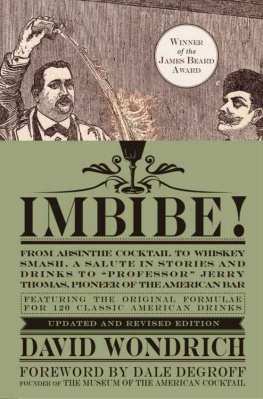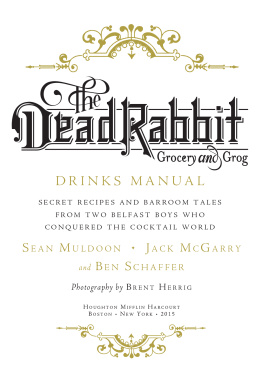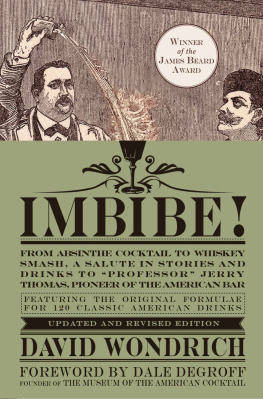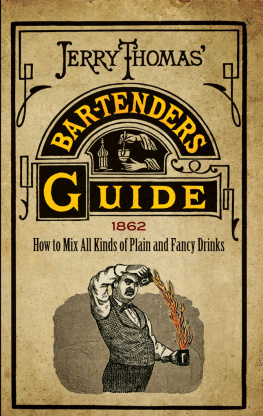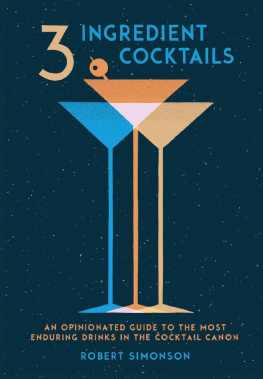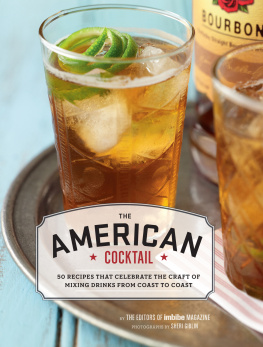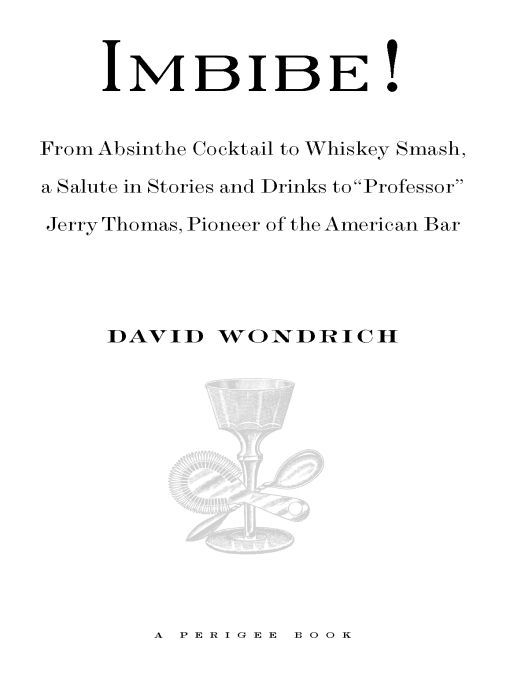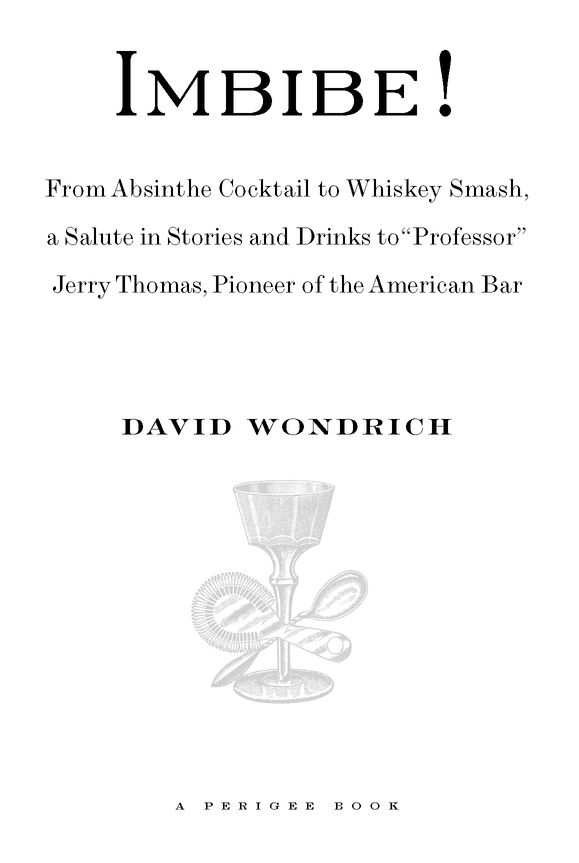Table of Contents
Imbibe! rescues barman Jerry Thomas, an American hero, from the dustbin of history. We drinkers and readers are in the debt of his scribe, Dave Wondrich, who proves an engaging and intellectually curious guide to the barroom netherworlds where bottle conjurers and other neer-do-wells carved their deeds in ice.
John T. Edge, author ofSouthern Belly: The Ultimate Food Lovers Companion to the South
David Wondrich has drunk his way through two centuries of American cocktails and other mixed drinks. He emerges to tell us, with clarity and wit, what he encountered, how it was made, and how to make it now. In his re-creations of the drinks of yesteryear, he stops at nothing, even growing his own snakeroot to make Jerry Thomass Bitters. Thomas was called the Professor in his day. If this title belongs to any living expert on the cocktail, it belongs to Wondrich.
Lowell Edmunds, author ofMartini, Straight Up
David Wondrich is such an envy-producing polymath that it drives me to drink. Brilliant historian, beautiful writer, former punk rocker, absinthe-maker, mixological marvel, and perhaps, yes, even wizard. Plus he can grow an amazing beard. There are few people in the world I rely on to be so authoritative and so entertaining all at once, and to mix an amazing cocktail at the same time. And those few people are David Wondrich.
John Hodgman, author ofThe Areas of My Expertise
FOR MARINA
FOREWORD
Back in 1985, when the legendary New York restaurateur Joe Baum asked me to create a classic bar for him at the fine dining restaurant Aurora, he sent me on a search for a book that would explain what he meant by a classic bar: How to Mix Drinks, or The Bon Vivants Companion by Jerry Thomas. After my initial unsuccessful attempts searching bookstores and without the Internet for quick reference, I finally discovered that Joe had neglected to mention that the book was written in 1862 and had been out of print since the Herbert Asbury edition was published in 1928. Eventually I got my hands on a copy of the later edition and started down a road that changed my thinking about bars and cocktails, and brought me to the Rainbow Rooma road that led to a revival of interest in real drinks made in a culinary style with real ingredients following original recipes, which continues to this day.
The bigger-than-life characters found in Jerry Thomass world actually seemed familiar to me, given my deep working knowledge of numerous New York City watering holes in the late 1960sjoints where the collection of con men, politicians, sporting types, and jazz-loving foreigners was as colorful as the crowd in any Bowery music hall of the mid-nineteenth century. The bartenders at Jimmy Ryans Club, where I practically lived back in those days, would have been right at home in one of Thomass saloons; they could determine as you approached the bar whether you had two nickels to rub together and give you the bums rush before you could open your mouth to order.
Colorful characters aside, what the barrel-chested and bejeweled Jerry Thomas embodied that has been lacking in the post-Prohibition bars in this country is an insatiable curiosity for the strange-sounding concoctions collected during extensive travels and adapted to his personal styleconcoctions, I soon discovered, that were crafted from ingredients half of which no longer existed. But that left me undeterred in my quest to make Joe Baums vision of a classic bar a reality.
Jerry Thomass book taught me how to craft drinks without the aid of commercial mixers; remember, all we knew as journey-men bartenders in those years was what we had learned from other untrained bartenders who came before us. That usually comprised a shot of spirits and a good portion of sour mix or daiquiri mix and a shake. The artificial foaming agent in the mix made the drink look great; as for flavor, those who wanted it drank straight spirits. Bloody Marys were one of the few drinks we made from scratch, and not many knew how to prepare a decent Bloody Mary mix with the right balance between the hot pepper and the sweet tomato juice.
Thomas talked about sugar syrups and how to make and then use them with fresh citrus juices. He was not generous with descriptions on technique and how to assemble these drinks, but there were enough hints here and there to fill in the blanks. Those hints, and lots of trial and error, led to my first all-fresh-ingredient cocktail menu at a time when cocktail menus were as rare as hens teeth. When I moved to the Rainbow Room with my newfound skills and the benefit of Joes celebrity and public relations machine behind me, the idea of old-as-new-again became the cutting edge; classics revived made quite the splash in the trade and eventually in the general market.
Back then I could have used a book like David Wondrichs as a teaching tool, to take the bartenders through the logical steps of punch to sling to cocktail, allowing them to experience firsthand how the whole culture of the cocktail evolved; even tasting them through the steps.
Wondrich has provided us with the most important and authoritative book on the American cocktail to date. He pitches and swaggers his way through the eighteenth, nineteenth, and twentieth centuries, from poems to periodicals, from songs to books, becoming more intoxicated with each new find. As the pieces accumulate like an enormous jigsaw puzzle, the picture begins to make more and more sense.
Against the backdrop of Western civilization, the cocktail, like the whole American experiment, is in its infancy. But the nature of this bibulous traditionborn, as Wondrich so deftly demonstrates, in the sporting lifeis such that even though all the drinks, stories, and recipes are less than 250 years old, there is very little left in the way of documentation.
Undeterred, Wondrich has uncovered a remarkable trail left like broken twigs on a forest path that lead the reader through the gaming rooms, saloons, gentlemens clubs, and coffeehousesto reveal the real story of the evolution of the American cocktail.
Dale DeGroff, founder,
The Museum of the American Cocktail
INTRODUCTION
My introduction to Jerry Thomas wasnt nearly as dramatic as Dalescharacteristically, I read about him in a book, one or another of the various histories of American lowlife Herbert Asbury published in the 1920s and 30s. It was the early 1990s, and I was in graduate school, keeping my head down and anticipating a somewhat dull but (I hoped) pleasant life in academia. Asburys raffish accounts of old New York, San Francisco, Chicago, and New OrleansI read them alland their various thugs, crooks, players, and sports were a lot more colorful than the Latin scientific poems I was studying. But work is work, so I reluctantly shelved Gallus Mag and Bill the Butcher, Bathhouse John, Belle Cora, and the bartender known as the Professor (who seemed to be in every book) and got back to my Manilius and Martianus Capella.
But funny things happen sometimes. Toward the end of 1999, I found myself working as an assistant professor of English at a Catholic college on Staten Island, and my place in academia fully as dull, but not nearly so pleasant, as I had pictured it. So when I got a phone call from my friend Josh Mack, then a honcho in Hearsts New Media division, asking if I might be interested in a little side project, I was pretty receptive. And when I found out that the project involved adapting the cocktail section from one of


